When done right, steamed whole fish is tender, juicy, and flavorful (with mouthwatering umami, savory, and sweet flavors)! Plus, it's easier than you think. I share step-by-step instructions for how to steam Chinese fish, a traditional staple in many East Asian households.
It’s perfect for Lunar New Year as it symbolizes prosperity and abundance, but easy enough to enjoy regularly. Wondering how to pick fresh fish and what to say at the seafood counter? I'll show you below (with photos).

jump to:
✨ why you'll love this recipe
This steamed fish recipe (qīngzhēng yú 清蒸魚 in Mandarin, Chinese) comes out delicate and tender, with a sauce that's full of flavor just like the Cantonese steamed fish you'd find at restaurants. I’m going to share all the chef secrets and break it down step-by-step so you can make restaurant-quality fish at home.
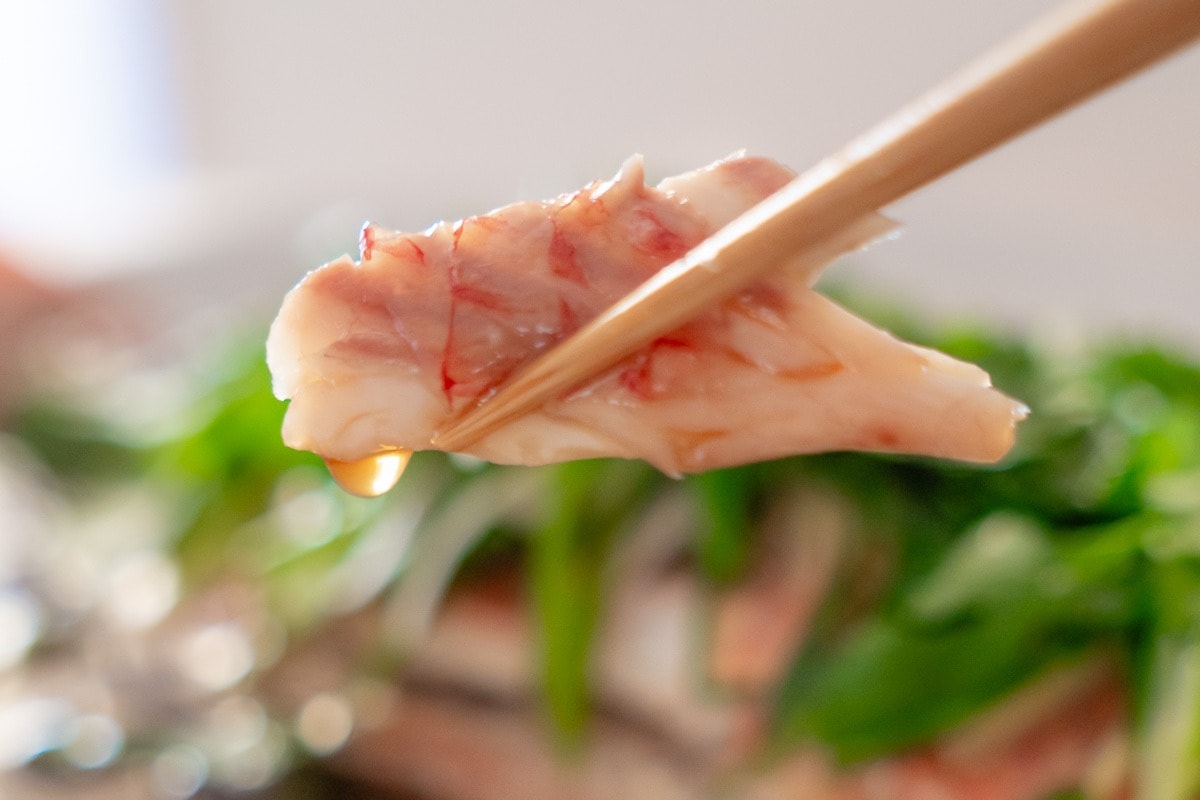
I'll show you how to top the fish with sizzling oil to help the aromatics like scallions and ginger bloom without overwhelming the fish itself. I created this dish to have a balance of flavors that complement the fish rather than overpower it.
How do I know all the chef secrets?
I watched my chef dad make steamed fish using live whole fish many times throughout my childhood, usually for Chinese and Taiwanese patrons at his restaurants or for staff family meals. I also witnessed my grandmother and aunt make it at least twice a month for family dinners.
While the process of cooking a whole fish is often reserved for special occasions like banquet-style dinners and celebrations, it’s also enjoyed in the smaller family moments that stick with us for life.
Serve it with stir-fried water spinach, Taiwanese cabbage, or a beautiful Din Tai Fung copycat cucumber salad.
As you’re enjoying your flavorful meal, keep in mind that steamed fish is an important dish during the Lunar New Year in Taiwanese, Cantonese, and Chinese households because of the symbolism behind it. This Chinese New Year fish is a symbol of prosperity and abundance! You could say it's good luck Chinese food.
the significance of fish: In Mandarin, the Chinese word for fish, 魚 (yú) sounds like the word for surplus (餘) and there’s a Chinese New Year greeting or proverb, 年年有餘 (nián nián yǒuyú), that you say to wish someone abundance and surplus year after year – food, health, wealth, love, etc. is implied.
To round out your meal, add a light soup and white rice or noodles and it’s complete!

more lunar new year meals
Here are a few more Lunar New Year foods to try.
- Taiwanese hot pot – my personal favorite!
- Boiled dumplings with shrimp and snow pea leaves
- Longevity noodles
- Tang yuan
- Fried nian gao (Chinese new year cake, finished Taiwanese-style)
- Finish with a comforting bowl of red bean soup
I'll walk you through how to pick fresh fish and how to approach the seafood counter below (since I know it can be intimidating!). Not interested in that info? Feel free to jump straight to the printable recipe by clicking the button below.
🎣 how to pick fresh fish
In Taiwan and in larger cities in the States, you can find restaurants that will make this dish with freshly caught fish or even live fish straight from a tank.
I’ve seen Cantonese and Chinese restaurants in the U.S. with fish tanks filled with live fish that they’ll steam whole using this method. This is important because fresh, high-quality fish is best for this recipe!
Most of us will not be fishing for our meal, so here are a few things to look out for when shopping for steamed Chinese fish.
quick tips on what to look for
- The fish should be stored on top of ice
- Look for fish with clear eyes and avoid any with cloudy eyes
- The fish shouldn’t smell super fishy - fresh fish smells more like sea water!
- The flesh should feel firm and plump (springs back when you press down)
- The gills should be bright red to dark red, but not black or super dark (they darken over time, so it's a good indication of how fresh the fish is).
- The fish and gills should also be slime-free

The fish should be stored on top of ice!

Look for fish with clear eyes and avoid any with cloudy eyes.

Check the gills - they should be bright red to dark red, but not black or super dark. The flesh should feel firm and plump (springs back when you press down).

The fish and gills should also be slime-free.
🐟 how to navigate the seafood counter
Once you have selected your fish, ask the fishmonger at the seafood counter to clean the fish for you - this includes de-scaling and gutting. I prefer leaving the fins as-is for presentation purposes, but you can request for them to be cut off too if you’d like.
At local Asian markets, they will sometimes have complimentary services to clean the fish just the way you need it. For example, at a 99 Ranch Market in California, you can see their services in the photo below. For this recipe, choose option 1 - clean only.

It can sometimes be intimidating at a seafood counter, but don't worry, I'll walk you through what to do.

- Grab a number (usually somewhere at the counter).
- Check out the fish displayed on ice and pick out the one you'd like. They're usually labeled with the type of fish, but you'll want to pick out the specific fish with clear, non-cloudy, eyes.
- When your number is called, point to the exact fish you want and ask them to clean it (it helps to say the number of the service you want to avoid confusion). So in this case, you would say "number 1, clean only please."
- And that's it! The fishmonger may clean it right there behind the counter or take it to the back, then wrap it up for you and add a pricing label.
- If you have a long drive home, you can ask for some ice in a plastic bag (I always double bag it myself so there aren't any leaks). Then you can place the wrapped fish into the bag with ice. Or better yet, bring your own cooler with ice packs to leave in your car.
📋 key ingredients
Here are the key ingredients you'll need to steam a whole fish Chinese-style!

- fish - I recommend using whole striped bass, sea bass, or tilapia (about 1 ½ pounds / 680 grams), de-scaled and cleaned by the fishmonger (see note). Tilapia is shown above.
- fresh ginger - peeled and thinly sliced into matchsticks
- salt - I use the Diamond Crystal brand kosher salt (paid link) since it has lower sodium levels, making it easier to layer the seasoning without accidentally oversalting a dish. It can be found in some grocery stores. ✴️ If using sea salt or table salt, use half of the amount listed in the recipe.
- sugar - I prefer granulated cane sugar for its mellow sweetness.
- light soy sauce - this is a soy sauce that's lighter in color (not sodium). Kimlan (paid link) is a popular brand used in Taiwanese cooking.
- water - plus more for the steamer,
- ground white pepper - this is optional but I highly recommend it for an added elevated flavor profile!
- scallions - ends removed and thinly sliced on a bias (at an angle).
- fresh cilantro - roughly chopped with stems and all.
- oil - both canola oil and sesame oil.
See the recipe card for quantities.
📖 substitutions & variations
- fish - Other types of white, delicate fish will work for this recipe too (red snapper and even branzino will work as well).
- gluten-free - use a Taiwanese soy sauce that's brewed without wheat, or opt for tamari.
- oil - Any neutral-flavored oil with a high smoking point will work. In restaurants, peanut oil is often used.
🔪 instructions
I’m going to go through each step in detail below, including step-by-step photos of how to prepare the fish for steaming. In a hurry? You can jump straight to the printable recipe.
gather your equipment for a steaming apparatus
I use a 14-inch wok with a steamer rack and domed lid. Don't forget that some appliances come with steamer racks – I'm using one that came with my air fryer! The steamer tray that comes with a Tatung cooker, placed on top of an upside-down heat-proof bowl would work too.
prepare the aromatics
Normally, I would prepare other ingredients while something is cooking/steaming, but for this recipe I like to have everything ready before steaming. That way I don't risk overcooking the fish.
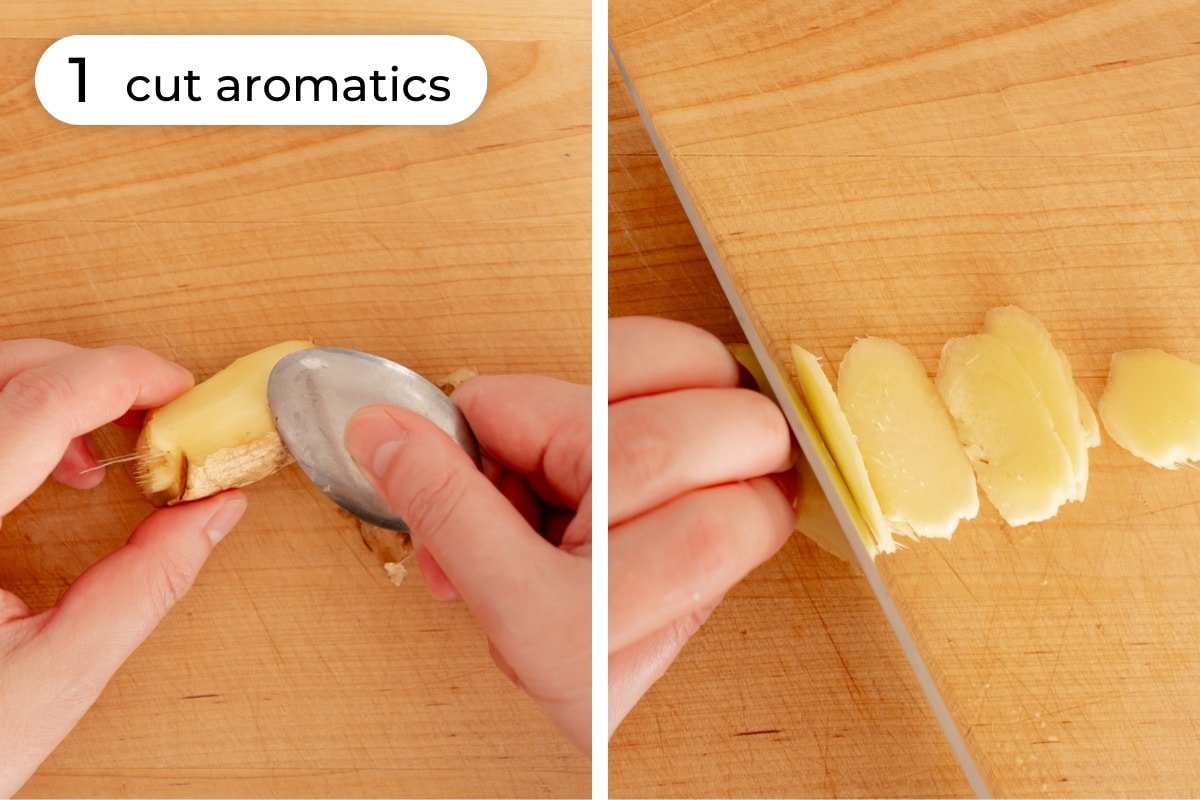
Peel a 2-inch piece (50-mm) of fresh ginger. It's easier with a small metal spoon, so that you can get into all the nooks and crannies easier.
Thinly slice the ginger at an angle, against the grain.
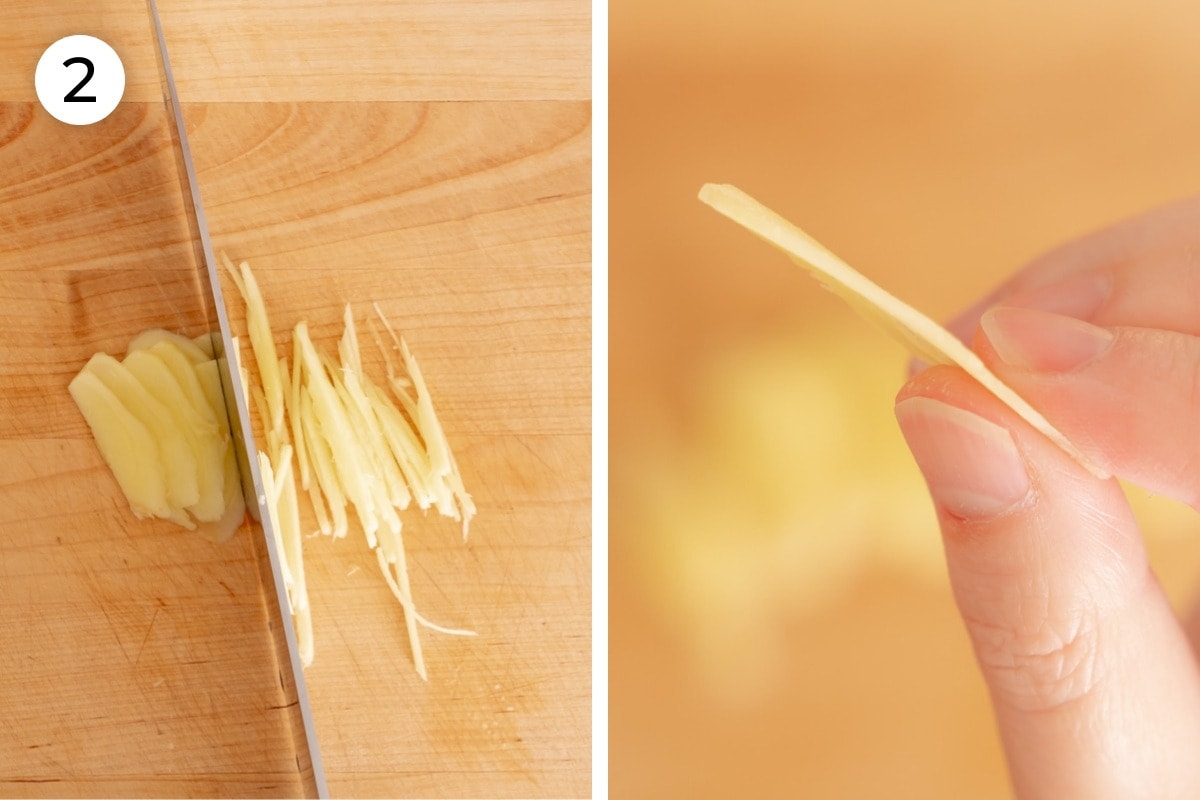
Fan out the thin slices on your cutting board and cut into thin matchstick sized slices (julienne) from right to left (or the opposite if you're left-handed).
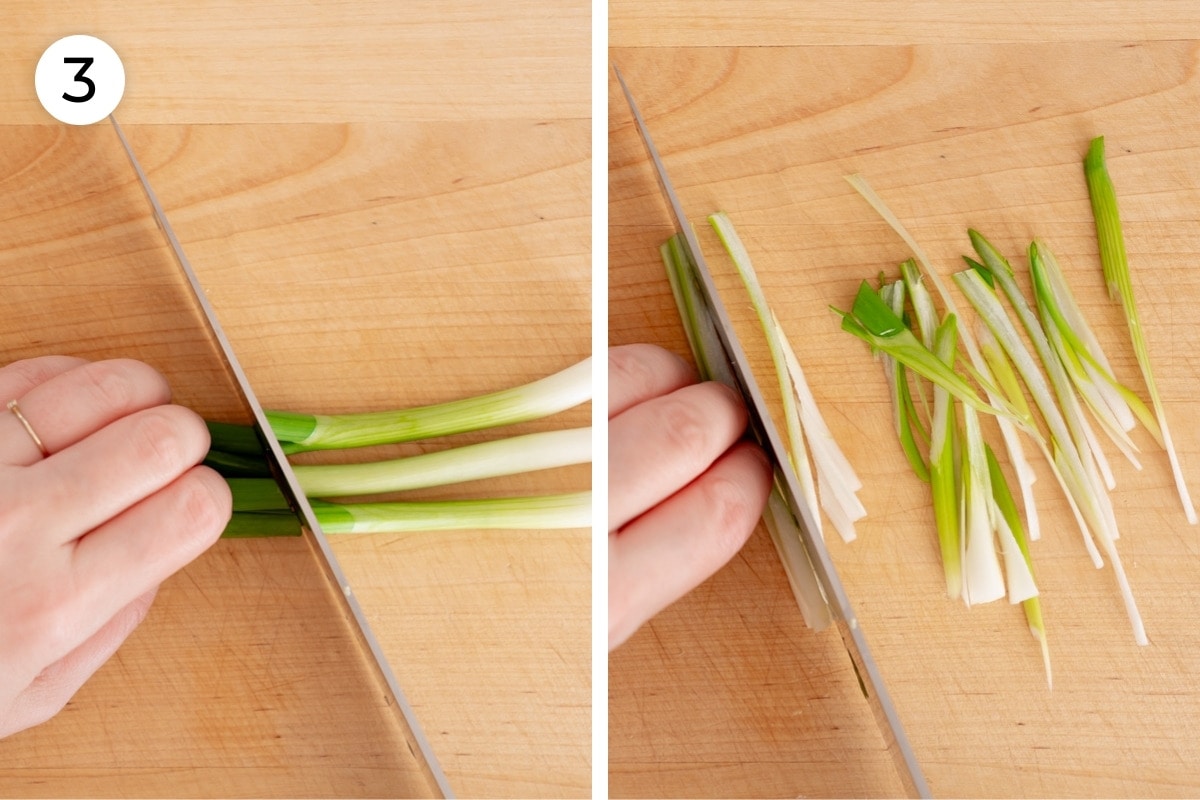
Cut the ends off of 5 scallions, then cut them in half, separating the white and green parts. Thinly slice.

Roughly chop 10 sprigs of cilantro, stems and all.
prepare the fish and steamer
Now, to prepare the fish (about 1½ pounds / 680 grams of whole fish – striped bass, sea bass, or tilapia) that has already been de-scaled and cleaned (gutted) by your local fishmonger at the seafood counter.
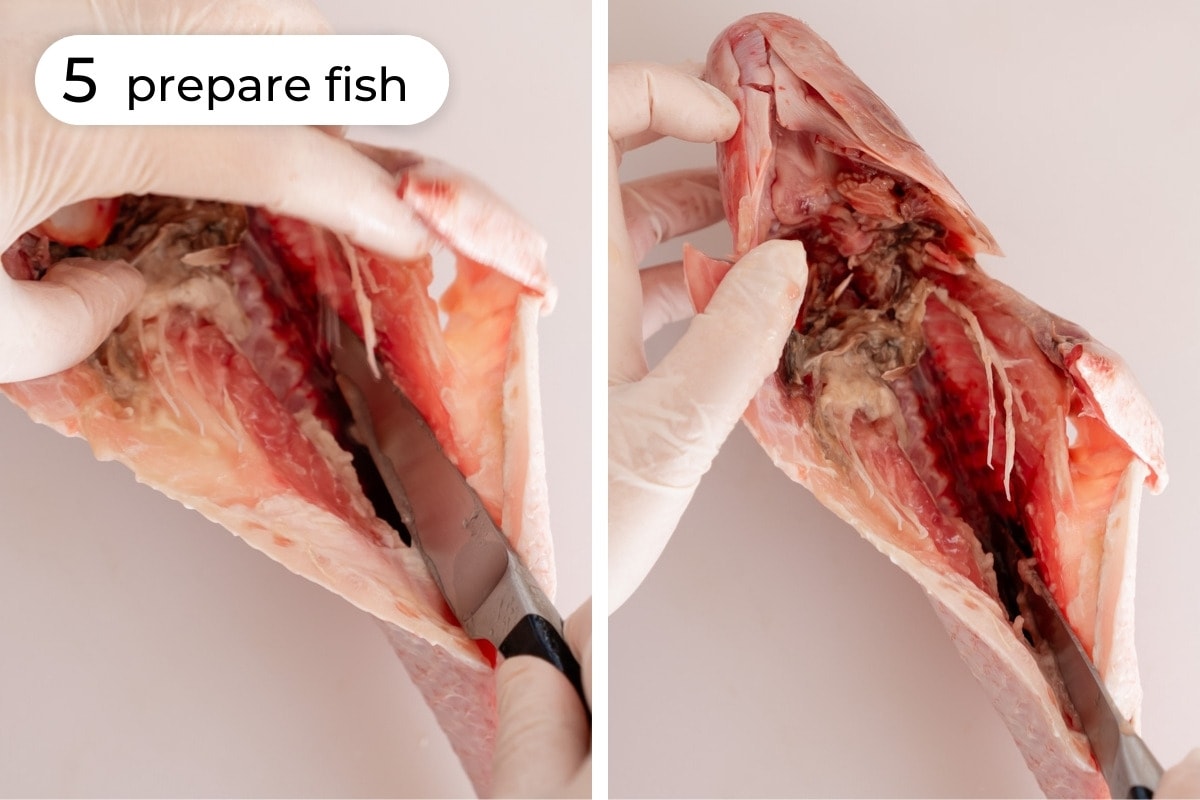
Use a pairing knife or metal spoon to scrape away any blood inside the fish near the backbone.

Rinse the outside and inside of the fish under cold running water to remove any lingering blood or scales, then pat dry with paper towels.
Watch out for the bones and fins when handling fish.

Lay the fish flat on a non-porous cutting board with the tail pointed towards you.
Using one smooth slicing motion, cut along the edge of the top fin about 1½-inch deep (parallel to the cutting board) from the head to tail using the backbone to guide your cut.

Gently flip the fish over and make the same cut on the other side.
Lay the whole fish on a large heat-proof plate that’s big enough for the fish, but small enough to fit in a 14-inch wok or your steamer. I use either an oval shaped plate or large round plate.

This is how the cut on each side looks. It'll help the fish cook more evenly without overcooking.
how to steam chinese fish

To steam, place a metal steam rack inside of a 14-inch or larger wok. Add water to the wok until it’s just below the top of the steam rack.

Then, place the heat-proof plate with your fish on top of the steam rack.

Top the fish with half of the thinly sliced ginger, spreading it out to cover more surface area of the fish.

Cover the wok with a domed lid and turn the heat on high until the water boils, then lower to medium heat. Steam for 8 minutes and turn off the heat.
pro tip: If your wok or steamer is smaller and won’t fit a whole fish, you can also use a wide saute/fying pan (paid link) with a domed lid (paid link) that fits.
Alternatively, ask the fishmonger to help you cut the fish in half. That way, you’ll have two shorter pieces to steam. Once steamed, you can place the two halves together on a plate so that it looks whole. I don’t recommend doing this for Lunar New Year celebrations though.
sauce and finish

While the fish steams, prepare the sauce by mixing ½ teaspoon Diamond Crystal kosher salt (use half the amount if using sea salt or table salt), 1 tablespoon sugar, 3 tablespoons light soy sauce, ½ cup filtered water, and ⅛ teaspoon ground white pepper in a small bowl. Set aside.

Check if the fish is cooked through by lifting a small piece with clean chopsticks. The meat should be opaque (white) throughout and slightly flaky yet still soft.
Be sure to check the meat close to the bone as well. The bone itself, should still be somewhat translucent.
If needed, steam the fish for 1-2 more minutes and check again. The steam time will depend on the size of your fish and steaming apparatus - for example, a 2½ pound (1134 grams) fish may take 10 minutes.

Carefully remove the plate with steamer tongs or dry kitchen towels.

While holding the fish in place, pour the liquid that has accumulated on the plate into a small bowl. Allow it to cool and then store it in an airtight container in the refrigerator - this liquid can be reserved for other uses.

Top the steamed fish with the sliced ginger, scallion, and chopped cilantro and spread out evenly.

In a small skillet, heat 2 tablespoons of canola oil and 1 tablespoon of sesame oil until the oil is hot (when ripples start to form when you slightly tilt the pan). Slowly pour the hot oil over the fish, making sure to distribute the hot oil over most of the aromatics.

You should hear the ginger, scallions, and cilantro sizzle (and it will smell amazing!).

Dish the sauce onto the plate around the fish. Serve immediately.

Now you have the perfect Chinese steamed fish with ginger and spring onion!
Make sure to warn your guests about fish bones, including small ones!
chef's tip: Include a large serving spoon with the whole fish to help with de-boning and dishing the flavorful sauce over rice.
🍲 equipment
Note: Some of the links below are affiliate links, which means we do make a small profit from your purchases (your price is not affected by this commission). We are a participant in the Amazon Services LLC Associates Program, an affiliate advertising program designed to provide a means for us to earn fees by linking to Amazon.com and affiliated sites. If you click on an affiliate link, you consent to a cookie being placed on your browser for purposes of tracking commissions.
You don't have to use all of the equipment I've listed below, but here are some options for you to choose from. If you don't have a steamer, feel free to use a wok with a domed lid (see paid link below).
- 14-inch wok – not a paid link, but a high quality and affordable wok I've been using at home.
- domed lid for 14-inch wok/pan
- steamer rack
- steamer tongs – every Taiwanese household needs these! They're so useful.
- small skillet
- chefs knife
- cutting board
❄️ storage
Allow the fish to cool completely. You can debone it and then store in the refrigerator in an airtight container for up to 1 day. I recommend enjoying it freshly cooked though since the fish will be overcooked when reheated.
To reheat the steamed fish, steam it again until hot so it doesn't dry out.
💭 top expert tips
- The liquid that accumulated on the plate where the fish was steaming can be used in other recipes. Allow it to cool and then store it in an airtight container (in the refrigerator) for later. You can use it in soups, sauces, or some people enjoy drizzling it over rice (it'll be concentrated in fish flavor though!).
- If your wok or steamer is smaller and won’t fit a whole fish, you can also use a wide saute/fying pan (paid link) with a domed lid (paid link) that fits.
- Alternatively, ask the fishmonger to help you cut the fish in half. That way, you’ll have two shorter pieces to steam. Once steamed, you can place the two halves together on a plate so that it looks whole. I don’t recommend doing this for Lunar New Year celebrations though.
💭 faq
The time your fish takes to steam will depend on how big your steaming apparatus is (wok, steamer, a wide saute/frying pan on the oven, etc.) and how large the fish is. In this recipe, I suggest starting with 8 minutes for a 1 ½ pound (680 grams) whole fish, but be sure to check the meat for doneness.
It should be opaque (white) throughout yet still soft. Take a peak at the bone too, it should still be somewhat translucent. If necessary, steam the fish for 1-2 more minutes and check again.
I suggest white, delicate fish for steaming. My preference for this recipe is striped bass, sea bass, or tilapia. However, other types of white fish will work for this recipe too. Red snapper and branzino are great as well. Ultimately, the best fish to steam is fresh, high-quality fish, so make sure freshness is your priority.
The most common mistake people make when cooking fish is overcooking it! I know it can be tricky because you want to make sure it's done and safe to eat, but overcooked fish is the worst. You don't want dry and tough meat! See my tips on checking the doneness of your fish in this post.
🥬 perfect vegetable pairings
Looking for an easy side dish that goes well with steamed fish? Give these a try:
Let me know if you have any questions in the comments below.
Happy cooking! ~ Cindy 周昀
Want to get recipe updates, pro cooking tips, and nutrition info on East Asian ingredients straight to your inbox? Sign up here for a free PDF with cozy soup recipes.
Please give this recipe a star rating ⭐️⭐️⭐️⭐️⭐️ if you make it. I would love to hear from you! If you have any questions at all, let me know in the comments below.
steam chinese fish 清蒸魚
ingredients
- 1 whole striped bass, sea bass, or tilapia (about 1 ½ pound / 680 grams), scaled and cleaned by the fish monger (see note)
- 2- inch piece fresh ginger, peeled and thinly sliced into matchsticks
- ½ teaspoon Diamond Crystal kosher salt, use half the amount if using sea salt or table salt
- 1 tablespoon sugar
- 3 tablespoons light soy sauce
- ½ cup water, filtered (plus more for steamer)
- ⅛ teaspoon ground white pepper, optional
- 5 scallions, ends removed and thinly sliced on a bias (at an angle)
- 10 sprigs fresh cilantro, roughly chopped with stems and all
- 2 tablespoons canola oil
- 1 tablespoon sesame oil
*The Instacart button above is an affiliate link, which means we do make a small profit from your purchases (your price is not affected by this commission).
instructions
prepare the fish and steamer
- Use a pairing knife or metal spoon to scrape away any blood inside the fish near the backbone. Rinse the outside and inside of the fish under cold running water to remove any lingering blood or scales, then pat dry with paper towels. Watch out for the bones and fins when handling fish.1 whole striped bass
- Lay the fish flat on a non-porous cutting board with the tail pointed towards you. Using one smooth slicing motion, cut along the edge of the top fin about 1½-inch deep (parallel to the cutting board) from the head to tail using the backbone to guide your cut. Gently flip the fish over and make the same cut on the other side.
- Lay the whole fish on a large heat-proof plate that’s big enough for the fish, but small enough to fit in a 14-inch wok or your steamer. I use either an oval shaped plate or large round plate.
- To steam, place a metal steam rack inside of a 14-inch or larger wok. Add water to the wok until it’s just below the top of the steam rack. Then, place the heat-proof plate with your fish on top of the steam rack.
prepare other ingredients and steam
- Top the fish with half of the thinly sliced ginger, spreading it out to cover more surface area of the fish. Cover the wok with a domed lid and turn the heat on high until the water boils, then lower to medium heat. Steam for 8 minutes and turn off the heat.2- inch piece fresh ginger
- While the fish steams, prepare the sauce by mixing the salt, sugar, light soy sauce, water, and ground white pepper in a small bowl. Set aside.½ teaspoon Diamond Crystal kosher salt, 1 tablespoon sugar, 3 tablespoons light soy sauce, ½ cup water, ⅛ teaspoon ground white pepper
- Check if the fish is cooked through by lifting a small piece with clean chopsticks. The meat should be opaque (white) throughout and slightly flaky yet still soft. Be sure to check the meat close to the bone as well. The bone itself, should still be somewhat translucent. If needed, steam the fish for 1-2 more minutes and check again. The steam time will depend on the size of your fish and steaming apparatus - for example, a 2½ pound (1134 grams) fish may take 10 minutes.
- Carefully remove the plate with steamer tongs or dry kitchen towels. While holding the fish in place, pour the liquid that has accumulated on the plate into a small bowl. This liquid can be reserved for soups, sauces, or some people enjoy drizzling it over rice.
- Top the steamed fish with the sliced ginger, scallion, and chopped cilantro and spread out evenly. In a small skillet, heat 2 tablespoons of canola oil and 1 tablespoon of sesame oil until the oil is hot (when ripples start to form when you slightly tilt the pan). Slowly pour the hot oil over the fish, making sure to distribute the hot oil over most of the aromatics. You should hear the ginger, scallions, and cilantro sizzle (and it will smell amazing!).2- inch piece fresh ginger, 5 scallions, 10 sprigs fresh cilantro, 2 tablespoons canola oil, 1 tablespoon sesame oil
- Dish the sauce onto the plate around the fish. Serve immediately. Make sure to warn your guests about fish bones, including small ones!
equipment and highlighted ingredients
notes
- The fish should be stored on top of ice
- Look for fish with clear eyes and avoid any with cloudy eyes
- The fish shouldn’t smell super fishy - fresh fish smells more like sea water!
- The flesh should feel firm and plump (springs back when you press down)
- The gills should be bright red to dark red, but not black or super dark (they darken over time, so it's a good indication of how fresh the fish is).
- The fish and gills should also be slime-free
🌡️ food safety
- Do not use the same utensils on cooked food, that previously touched raw fish
- Wash hands after touching raw fish and before handling fresh herbs
- Don't leave food sitting out at room temperature for extended periods
- Never leave cooking food unattended
- Always have good ventilation when using a gas stove
- See more guidelines at USDA.gov.















YeeYan says
Cindy’s recipes are some of my absolute favorites! She uses authentic ingredients and takes the time to nurture the recipe until it’s ready to be shared. Her cooking has purpose. This recipe is very detailed step by step and it was delicious!!
cindy chou says
Thank you so much, YeeYan!! This makes me so happy. Appreciate you taking the time to try my recipes and provide feedback. You're the best!